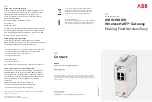
User's Manual
370
Document #: LTRT-89729
Mediant 3000
Alternative Routing based on SIP Response Code Example
Destination
Phone Prefix
IP Destination
SIP Response
Rule Used?
Main Route
40
10.33.45.68
408 Request
Timeout
No
Alternative Route
#1
40
10.33.45.70
486 Busy Here
No
Alternative Route
#2
40
10.33.45.72
200 OK
Yes
Proxy Sets:
Proxy Sets are used for Server-type IP Groups (e.g., an IP PBX) and
define the actual IP destination (IP address or FQDN) of the server. As you can define
up to five IP destinations per Proxy Set, the device supports proxy redundancy, which
works together with the alternative routing feature. If the destination of a routing rule in
the Outbound IP Routing table is an IP Group, the device routes the call to the IP
destination configured for the Proxy Set associated with the IP Group. If the first IP
destination of the Proxy Set is unavailable, the device attempts to re-route the call to
the next proxy destination, and so on until an available IP destination is located. To
enable the Proxy Redundancy feature, set the IsProxyHotSwap parameter to 1 (per
Proxy Set) and set the EnableProxyKeepAlive to 1.
When the Proxy Redundancy feature is enabled, the device continually monitors the
connection with the proxies by using keep-alive messages (SIP OPTIONS). The
device sends these messages every user-defined interval (ProxyKeepAliveTime
parameter). Any response from the proxy, either success (200 OK) or failure (4xx
response) is considered as if the proxy is communicating. If there is no response from
the first (primary) proxy after a user-defined number of re-transmissions (re-INVITEs)
configured using the HotSwapRtx parameter, the device attempts to communicate
(using the same INVITE) with the next configured (redundant) proxy in the list, and so
on until an available redundant proxy is located. The device’s behavior can then be
one of the following, depending on the ProxyRedundancyMode parameter setting:
•
The device continues operating with the redundant proxy (now active) until the
next failure occurs, after which it switches to the next redundant proxy. This is
referred to as
Parking
mode.
•
The device always attempts to operate with the primary proxy. In other words, it
switches back to the primary proxy whenever it's available again. This is referred
to as
Homing
mode.
If none of the proxy servers respond, the device goes over the list again.
The steps for configuring alternative Tel-to-IP routing based on SIP response codes are
summarized below.
To configure alternative Tel-to-IP routing based on SIP response codes:
1.
Enable alternative routing based on SIP responses, by setting the 'Redundant Routing
Mode' parameter to one of the following:
•
Routing Table
for using the Outbound IP Routing table for alternative routing.
•
Proxy
for using the Proxy Set redundancy feature for alternative routing.
2.
If you are using the Outbound IP Routing table, configure alternative routing rules with
identical call matching characteristics, but with different IP destinations. If you are
using the Proxy Set, configure redundant proxies.
Summary of Contents for Mediant 3000
Page 2: ......
Page 26: ...User s Manual 26 Document LTRT 89729 Mediant 3000 Reader s Note...
Page 27: ...Part I Getting Started with Initial Connectivity...
Page 28: ......
Page 40: ...User s Manual 40 Document LTRT 89729 Mediant 3000 Reader s Notes...
Page 41: ...Part II Management Tools...
Page 42: ......
Page 44: ...User s Manual 44 Document LTRT 89729 Mediant 3000 Reader s Notes...
Page 80: ...User s Manual 80 Document LTRT 89729 Mediant 3000 Reader s Notes...
Page 98: ...User s Manual 98 Document LTRT 89729 Mediant 3000 Reader s Notes...
Page 103: ...Part III General System Settings...
Page 104: ......
Page 113: ...Part IV General VoIP Configuration...
Page 114: ......
Page 144: ...User s Manual 144 Document LTRT 89729 Mediant 3000 Reader s Notes...
Page 164: ...User s Manual 164 Document LTRT 89729 Mediant 3000 Reader s Notes...
Page 222: ...User s Manual 222 Document LTRT 89729 Mediant 3000 Reader s Notes...
Page 224: ...User s Manual 224 Document LTRT 89729 Mediant 3000 Reader s Notes...
Page 275: ...Part V Gateway and IP to IP Application...
Page 276: ......
Page 278: ...User s Manual 278 Document LTRT 89729 Mediant 3000 Reader s Notes...
Page 399: ...Part VI Session Border Controller Application...
Page 400: ......
Page 402: ...User s Manual 402 Document LTRT 89729 Mediant 3000 Reader s Notes...
Page 464: ...User s Manual 464 Document LTRT 89729 Mediant 3000 Reader s Notes...
Page 465: ...Part VII Stand Alone Survivability Application...
Page 466: ......
Page 474: ...User s Manual 474 Document LTRT 89729 Mediant 3000 Reader s Notes...
Page 494: ...User s Manual 494 Document LTRT 89729 Mediant 3000 Reader s Notes...
Page 497: ...Part VIII IP Media Capabilities...
Page 498: ......
Page 501: ...Part IX High Availability System...
Page 502: ......
Page 515: ...Part X Maintenance...
Page 516: ......
Page 522: ...User s Manual 522 Document LTRT 89729 Mediant 3000 Reader s Notes...
Page 524: ...User s Manual 524 Document LTRT 89729 Mediant 3000 Reader s Notes...
Page 552: ...User s Manual 552 Document LTRT 89729 Mediant 3000 Reader s Notes...
Page 562: ...User s Manual 562 Document LTRT 89729 Mediant 3000 Reader s Notes...
Page 565: ...Part XI Status Performance Monitoring and Reporting...
Page 566: ......
Page 578: ...User s Manual 578 Document LTRT 89729 Mediant 3000 Reader s Notes...
Page 609: ...Part XII Diagnostics...
Page 610: ......
Page 624: ...User s Manual 624 Document LTRT 89729 Mediant 3000 Reader s Notes...
Page 626: ...User s Manual 626 Document LTRT 89729 Mediant 3000 Reader s Notes...
Page 638: ...User s Manual 638 Document LTRT 89729 Mediant 3000 Reader s Notes...
Page 639: ...Part XIII Appendix...
Page 640: ......
Page 864: ...User s Manual 864 Document LTRT 89729 Mediant 3000 Reader s Notes...
Page 871: ...Version 6 6 871 Mediant 3000 User s Manual 55 Selected Technical Specifications Reader s Notes...
















































